Green Lantern: Lost Army #6 Review
on November 23, 2015
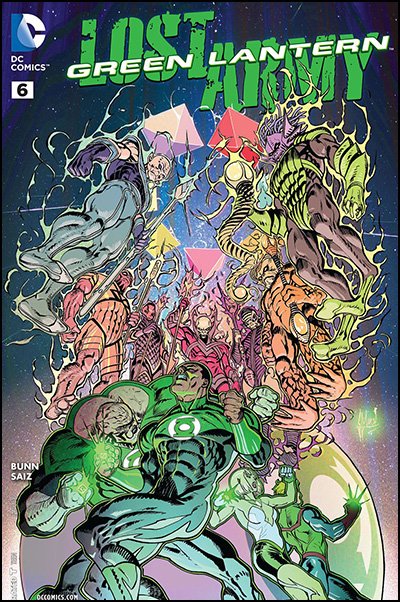
This is it! The final issue of Green Lantern: Lost Army. Cullen Bunn wraps up this tale with a critical battle on Mogo with game changing results. Bunn was put in quite a predicament. When he picked up this project, he was adamant about needing twelve issues to do the story justice. DC initially granted his request, but things went back and forth, with the number of planned issues eventually going from thirteen to six. Those who keep up with comic book news will know that the DC YOU initiative from DC Comics did not go as well as hoped. Retailers responded to DC’s new books and status quos with a general lack of interest, and I assume DC’s wishy washy attitude toward Lost Army was due to them debating whether to commit to the book, or re-launch it under a different creative team with the hope of enjoying a sales boost.
In the end, it seems that DC has gone with the latter option. The various DC editors were given the order to go back to a “meat and potatoes” approach instead of trying something drastically different with their books. Apparently, meat and potatoes for Green Lantern means the return of prolific Green Lantern: Rebirth artist Ethan Van Sciver, who will be doing the art for the upcoming Green Lantern Corps: Edge of Oblivion, which will pick up from where Lost Army ends. Tom Taylor, the writer of the digital hit Injustice: Gods Among Us, will be joining Van Sciver.
 |
|
Every page of this comic is gorgeous. I am seriously going to miss Jesus Saiz. |
This whole situation is bitter sweet to me. I would be perfectly happy to keep Lost Army going and have Bunn and Saiz go the distance. Bunn has a good grasp on John Stewart’s character and voice, and has introduced some intriguing concepts into Green Lantern, such as the the matter destroying cleaners and the use of telepathic sub-channels for communication via power rings. I also love the cast he has put together. And one only needs look at one of Jesus Saiz’s pages to see how stupendous he is. So, it’s upsetting that Lost Army is ending and we’re saying goodbye to this creative team. However, I’m really happy that the story will continue. When Lost Army’s cancellation was announced, I was quite anxious that it would be wrapped up hastily and clumsily, but knowing that DC is continuing the story sets me at ease quite a bit, and I look forward to what Edge of Oblivion will have to offer. This is the issue of Lost Army that brings us to the edge!
Dissenters have complained that nothing really happens in Lost Army, and while I don’t agree with that, even I had to admit that Cullen Bunn wasn’t very forthcoming with the reveals. Cullen Bunn amazingly manages to make this issue a very satisfying ending without rushing things along. Not everything is revealed, but there are enough surprises to make this issue pivotal and a good place to conclude this run. Every moment of this comic book feels grand and epic.
It starts with a desperate battle for Mogo, and Saiz immediately transports readers to the dire and frantic conflict with his vivid artwork. It’s night. Characters are fighting each other everywhere. Laser blasts are raining down from the sky. There’s confusion at every turn. It’s a very heavy scene and this explosion is what readers are thrown into at the beginning.
John sees Simon Baz on the battlefield and touches base with him. About Baz… I can’t say that I’m happy to see him. I’ve always seen him as an incredibly extraneous character that should have never been created in the first place. DC has never gotten me to care about him and I don’t know if they even can. I’d prefer if he wasn’t in Lost Army or Edge of Oblivion, but here he is. Oh well.
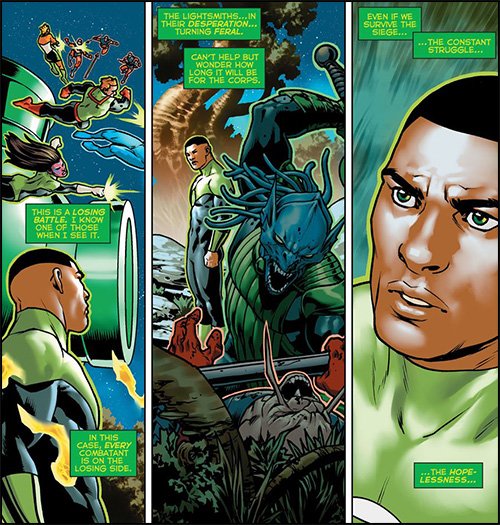 |
|
John Stewart considers the nonsense taking place around him. |
Baz tells John that the Lanterns on Mogo have been fending off Lightsmith attacks since they arrived in this universe. Every faction present is against everybody else. Baz is visibly exhausted and bloodied, which speaks of the grim situation. High above Mogo, Relic, Krona, and Salaak monitor the situation from Relic’s space ship. They deduce that the Lightsmiths are using their pyramid emotion converters to rain torrents of energy down upon Mogo in an effort to seize control of the living planet by terraforming him. Salaak believes Mogo won’t survive this process, or he will be driven mad.
Meanwhile, John is on the surface locked in battle with a Fear Lightsmith, who conjures up constructs of ghastly images of John’s Lantern party asking him why he let them die in the past universe. John keeps his resolve strong and blasts the Lightsmith, but then stops to really consider what the constructs said. He looks around at the carnage going on around him and considers that there will be no winners in a battle like this. There will be no winners for this universe. He knows that even if the Lanterns happen to survive this particular fight, the constant struggle of trying to survive in this volatile reality may very well break them and cause them to turn against each other just as the Lightsmiths have. Perhaps he’s thinking about his own conflict with Guy Gardner as well.
I really like this scene because it’s very reminiscent of the Mosaic John Stewart of the Gerard Jones era, who would literally—to his detriment, usually—stop and contemplate a desperate situation instead of taking immediate action. Here, John is considering the bigger picture instead of just being caught up in the concern of the moment, as everyone else understandably is. He knows he can’t allow things to go on like this, and gathers his will to lead the Lanterns home alive. He leads by example by not giving up hope.
Suddenly, Two-Six is caught in a torrent of energy coming from the blue power converter that’s blasting the planet and she is inexplicably turned into what appears to be some form of Blue Lantern. Other Lanterns get caught in converter energy waves and change color, most notably Guy Gardner, who goes back to being a full Green Lantern when he’s caught in a green beam. Both his power rings turn green, but before he can consider what that means, a massive earthquake ravages the surface of Mogo as the living planet yells “ENOUGH!” Mogo seizes control of the light energy through the emotional converter pyramids as they land on his surface, and with his control of it he breaks many of the Lightsmiths’ staves, causing them to retreat.
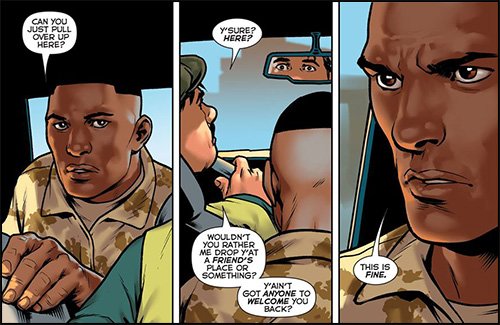 |
|
John returns from Afghanistan. But to what? |
Arisia tells John of how she’s happy with their victory, but she knows the Lightsmiths will be back. She says that they may have bought enough time to find a way home, though. John seems to be lost in thought, however. As he peers up at the twinkling Lightsmiths dotting the night sky in their retreat, he thinks back to a moment in his past.
His tour of duty in Afganistan is over and John has survived and made it back to the United States. While in a taxi, John asks the driver to drop him off at a motel. The driver asks John if he’s sure, wondering if John has anyone to welcome him back. John thanks the cab driver, takes his bag, and heads toward the motel. It’s interesting that this is the “home” he wanted to return to. He contemplates that nothing will ever be the same anymore. This is one of my favorite flashbacks from Lost Army. It’s very poignant. John has returned back to a life that was once familiar to him, but he has been forever changed and has to try to readjust back into it. Jesus Saiz gets the feeling of a crap motel down great, with the dull looking palm trees, empty parking lot, and depressing looking pool.
The next morning on Mogo, John and Arisia have a word with Salaak. John inquires about Mogo’s condition. Salaak has examined the planet and states that Mogo has been fundamentally altered. Mogo is now a living power battery. He can access and control all the different energies of the spectrum. Salaak hasn’t gotten a chance to analyze the Lanterns who were changed from green to different colors. This is a very interesting development for Mogo and the Corps, and I can’t help but wonder what it will mean for stories going forward. Will Lanterns be able to willingly shift to different colors by utilizing Mogo’s converters?
Salaak did manage to locate a fissure in time and space with the help of the sensors on Relic’s ship. It is emitting readings similar to what the Lanterns would regularly find in their universe. It turns out this fissure is at the Source Wall, and Mogo flies over to the edge of the universe so the Lanterns can get a look at this themselves.
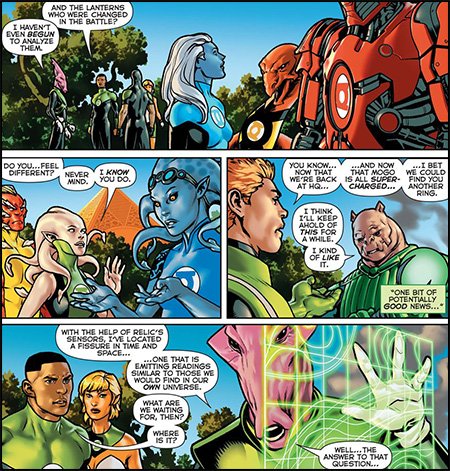 |
|
Strangely, many of the Lanterns have been changed to other colors during the battle. Whatever that entails will have to be explored in Edge of Oblivion. |
Jesus Saiz has been slaying it this entire issue, and one of the strongest images is his depiction of the Source Wall. This location is arguably the most epic in the entire DC Universe, and Saiz shows it with the grandeur and power it deserves. We see how Mogo measures against the scale of the wall, and the planet is fittingly diminutive.
When the Lanterns investigate the fissure, they see a bright light shining through a crack in the wall. Salaak believes that whatever force sent them to the past universe left it behind. John peers to the other side of the wall despite the near blinding light.
To his great surprise he sees someone on the other end. Hal Jordan is there, sealing the rift, trapping the Lanterns on the other side. John Stewart is stunned to see that it is Hal Jordan sealing the Corps away. To keep the Lanterns from losing hope, John decides to stay quiet about what he saw, and he sees it as having to lie again. He’s lied to Krona, Relic, and now to the Green Lanterns. With the rift closed, John says that all the Lanterns can do is keep flying and look for another solution.
It looks like John’s lies are about to catch up to him. Back on Mogo, Krona informs Relic that the Green Lanterns have no intention of helping him save this universe. Krona goes on to say that he may be able to devise a way to make it happen, and so ends Green Lantern: Lost Army.
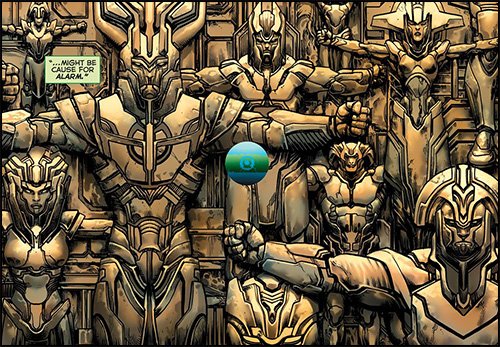 |
|
Jesus Saiz renders the Source Wall with the majesty and power it deserves. It’s a shame we don’t get to see him draw the Hand of Creation, too. |
We get two good reveals this issue. The first is that the Lanterns are beyond the Source Wall, and the second is that Krona is bad and has been biding his time to betray the Lanterns. I also highly doubt that Krona is at all interested in saving Relic’s universe. As I suggested in previous reviews, I wouldn’t be surprised if Krona has something to do with its destruction. He was likely always able to tap into the telepathic sub-channel that the Lanterns use to communicate, he just kept quiet about it this whole time.
The advances that are made in this issue are satisfying, but the dangling threads are many. The effects of John’s lies to Relic have yet to be seen, and we still don’t entirely know what Krona is doing in this reality. Why Guy Gardner had both a red ring and a green ring is unknown, and I’m not sure if it will even be explained. I think Bunn was headed somewhere with that, but perhaps incoming writer Tom Taylor didn’t want to go there and wanted Gardner set back to status quo. I hope I’m wrong and we get some answers about that. We also have no idea why Green Lanterns have been changed to other colors or what that means for the Corps. There are a lot of unanswered questions for Edge of Oblivion to address. That’s alright to me, though, because I see this transition as going from book one of a series to book two. Threads from book one often carry over to book two. what we don’t know is if the answers will be what Cullen Bunn had originally intended.
As a whole, Lost Army is one of the most visually beautiful Green Lantern series you will find anywhere. We John Stewart fans are fortunate to have the likes of Bernard Chang, Marcelo Maiolo, and Jesus Saiz working on the character lately. The landscapes are sparse, as the book takes place primarily in space, but Saiz manages to keep the astral scenery breathtaking. His work on the characters is some of the best, if not the best, to be seen from any artist. Saiz’s colors are full of depth, with excellent shading and highlights. The series has a very digital look, and while not at all bad in and of itself, it doesn’t look exactly like a traditional comic book, which could throw some people off, but I’m not one of them.
Concerning the writing, I have to praise Cullen Bunn for his handle on John Stewart’s character. He gets John’s thoughtful, responsible, and mature personality across well. This series serves as a great insight into John with flashbacks to specific moments in his past, which were welcome from me, with my favorites being from issue #4 and issue #6.
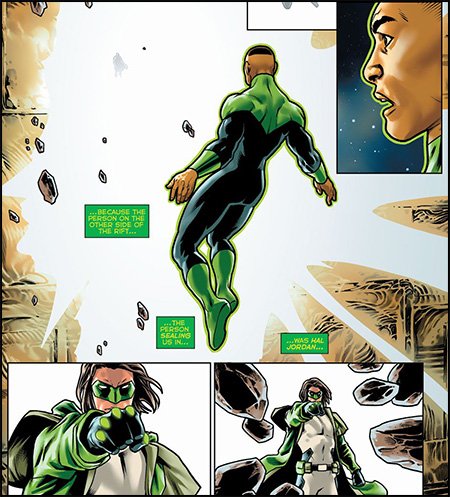 |
|
John Stewart looks to the other side of the wall. If the Lanterns are beyond the Source Wall, then where is the Source? This is another question for Edge of Oblivion to address. |
Bunn also did a great job at keeping the tension high throughout the entire series. Lost Army is certainly a story of survival, and the Lanterns are tested at every single turn, from their first battle with the cleaners, to Arisia’s ring being drained in space, to the final battle on Mogo.
The concept of Lost Army in and of itself is amazing. I’ve mentioned that this is the most fascinating concept from Green Lantern I’ve seen since Mosaic. Being trapped and lost in the universe before our own, which is destined to die to make way for our universe, is a great premise. There’s the conflict within the Lanterns between whether to save this universe and its people, or let it die since that is needed to see their own universe again. I love it when Green Lantern plays with grand cosmic subjects like the dawn of time and the Source Wall. Considering the nature of the franchise, there isn’t near enough of that, in my opinion, especially since the Hand of Creation is actually something that originates from Green Lantern. And I’m sorry, the Emotional Spectrum and all related things like the Entities don’t do it for me.
My main complaint with the writing is that John Stewart really didn’t do a whole lot for the Lanterns. Mogo, B’dg, Salaak, Krona, Relic, and even Guy Gardner performed greater feats toward saving the Corps. This series is weird, because when John isn’t doing anything important in stories, he’s usually ignored entirely. However, Lost Army is definitely a John Stewart story, and he led with a very strong presence, but he didn’t really have any particular feat that saw the Corps through their ordeal, except perhaps take the chance on charging his ring against the red emotional converter in issue #2, but it was Krona who told him he could do that. He did save Arisia from death in space in issue #4, which was nice to see, but it’s not like the Lanterns escaped or won that fight. John was never really the x factor that decided the outcome for the Corps, which is strange, since the story is largely about his leadership. Imagine Star Wars: A New Hope without Luke Skywalker destroying the Death Star, and instead having Biggs Darklighter take that spot. The movie and Luke’s character would really lose something.
If DC Comics wants to get more people behind John Stewart–and I hope that is the goal (although sometimes I wonder)–they’re going to have to give him better, more critical feats. At the risk of going off on a tangent, and this might sound kind of silly, but I think one of the problems John Stewart has faced is that he never had an influential ‘fanboy’ behind the scenes to champion and support him, with the closest we’ve had being Van Jensen. Because of that many of the writers don’t value John Stewart the way his fans do, so when it’s time to save the day, even in his own title, he is often not the one doing it.
The upside is that John Stewart is certainly not a Mary Sue, but he still he needs better feats if DC wants comic fans to respect him more. John Stewart fans love him no matter what, and the people who hate John Stewart will likely always hate him, but that critical group of neutral people whose opinion about him could go either way based upon his stories and what he does in them? I believe they’re going to need to be shown more reason why they should get behind this character. DC could do a much better job of that. They need to show us why John Stewart, in particular, is the leader of the Green Lantern Corps, and Lost Army, for all its strengths, does not do that effectively. I hope Edge of Oblivion delivers on that. Just so I’m clear, I don’t want to see an invincible, infallible John Stewart, but when he’s the hero in his own story he should do something critical to be the hero.
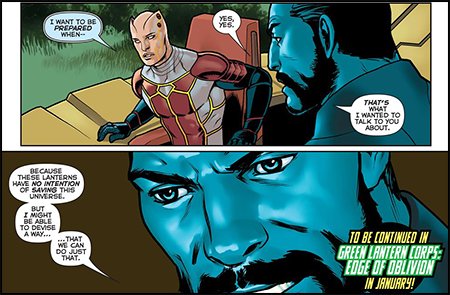 |
|
At last, Krona is ready to show his true colors. |
Another problem I have with Lost Army is that we did not see enough of this universe. The writers always bring out that this reality has amazing cities made of light, and they are only ever seen in narrative flashbacks, usually in a single panel. How about we actually go there for once? There wasn’t any real sense of culture in this universe, and I think that was a missed opportunity. I enjoyed all the outer space fighting and adventuring, but it couldn’t have hurt to actually touch base with a civilization sometimes.
The relationships between the characters didn’t advance much. John Stewart and Guy Gardner had really interesting moments, especially in issue #3, but aside from that, the characters and their interactions are more or less the same as before. The focus has mostly been on the Lanterns surviving, and there hasn’t been much downtime for the Lanterns to have moments, but a lot can arise from just the Lanterns trying desperately to live.
That said, the Lanterns’ dialogue bounced off each other well and no one was out of character. Despite not exploring the relationships between most of the characters, Bunn and Saiz do get across a strong sense of camaraderie among the Lanterns and I do get the feeling that going through all this together has strengthened their bond where it hasn’t stressed it. However, it would be nice to actually see confirmation of that instead of just me having to infer it. A brief celebration after a desperate battle, even if it’s just some cheering and a quick hug or something would go a long way toward making everything seem less wooden and add some levity and character. We saw something like this with Two-Six and Xrill in the latter issues, but it wasn’t much and there was a lot of room for more.
This final issue gets me really pumped for Edge of Oblivion while also making me miss Lost Army, and I think those are the best feelings it could have left me with. Cullen Bunn pushes the story along pleasingly and Jesus Saiz will take your breath away with every page. While there are things I wish Lost Army had done more of—I don’t know if Bunn would have gotten to them if he had the time—I highly recommend this entire series. It’s very strong in its own right and has given Edge of Oblivion a very solid foundation to work from. If you haven’t picked up any of the issues, you might want to give them a shot before Edge of Oblivion releases in January, or pick up the trade paperback when it’s released.
4.8 out of 5 stars.
Read Green Lantern: Lost Army #5 Review.
Read Green Lantern: Lost Army #4 Review.








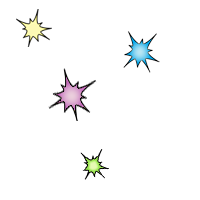





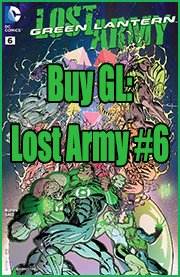





Pingback: Green Lantern: Lost Army #6 Review | Green Lantern John Stewart Website()